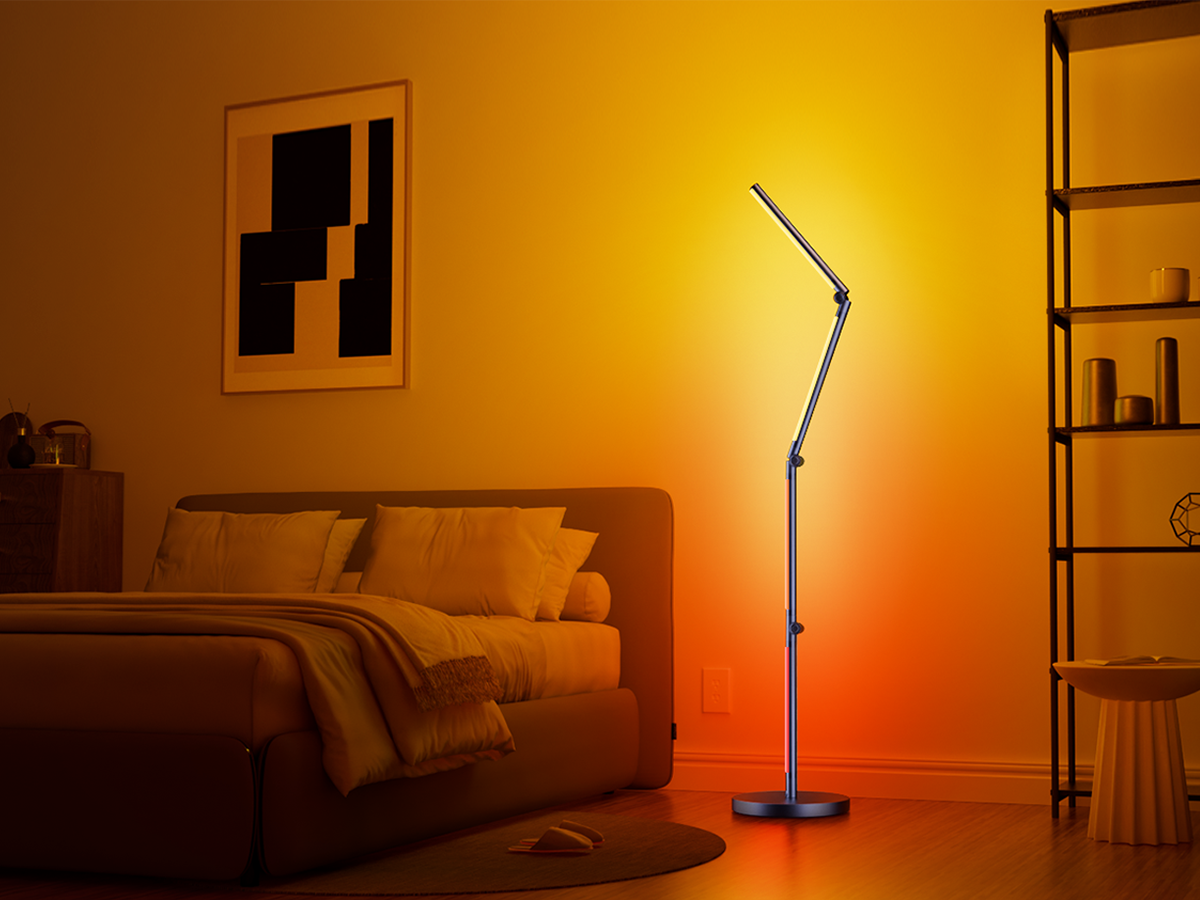Indoor Lights

Best Floor Lamp Color Temperature for Living Rooms & Bedrooms
Use warm white as the baseline and step up only when task clarity demands it. Most hold 2700–3000K in most living rooms for a relaxed feel and bump to 3000–3500K at a reading corner.
In bedrooms, keep 2200–2700K dimming for pre-sleep wind-down when one lamp must do everything, tunable white bridges daytime focus and night comfort.
Add illuminance targets so lumens translate to real results: living-room ambient 5–20 fc (≈50–200 lux), reading plane 30–50 fc (≈300–500 lux); estimate total lumens from area and placement, then verify on the task plane with a meter app or cheap lux meter.
Living Room: Best Color Temperature
Prioritize brightness and glare control before raising CCT. Text clarity improves first by hitting 30–50 fc on the page and shielding the source (shade, cut-off, narrower beam, adjustable head).
2700–3000K for TV/entertaining; 3000–3500K for a reading corner. Keep the room warm; push only the task zone into low-neutral for contrast.
Lumens per use (ambient vs. task): Ambient ~800–1,200 lm per floor lamp in typical rooms; 1,000–1,600 lm for darker schemes, high ceilings, or stronger wall wash.
CRI ≥ 90 for accurate colors. Keeps skin, wood, and textiles natural under warm light.
Quiet exemplar after the rules: a segmented RGBWW corner lamp (tunable 2700–6500K, up to ~1500 lm) sits at 2700K for movie night and jumps to ~3000K for tabletop games without moving the fixture (Decktok RGBWW Smart Corner Floor Lamp).
How to find equivalents: check CCT range, max lumens, CRI, beam/segment control, and tilt/rotation. If using replaceable bulbs, start with E26/E27, CRI ≥ 90, and 2700–3000K.

Bedroom: Best Color Temperature
2200–2700K for relaxation; cooler light raises alertness. Neutral/daylight feels stimulating at bedtime.
Brightness matters for circadian comfort. At night, lower illuminance in addition to warming CCT; aim well below daytime levels.
Dimming and tunable routines (evening wind-down). Two-point routine: brief reading at ~2700K and 30–50 fc on the page; then dim and drift to 2200–2400K for the last 30–60 minutes.
Subtle exemplar after the guidance: a tall projection-capable RGBWW lamp (~1600 lm, 2300–6500K, rotating head) covers low-glare reading and soft ambient wash in the same footprint (Decktok Smart Projection Floor Lamp).
How to find equivalents: confirm CCT span, output, head rotation, height for sightline control, plus app/voice control if needed. Bulb-based setups: E26/E27, CRI ≥ 90, warm presets.

Warm vs Neutral vs Daylight (photos side-by-side)
- Warm white (2200–3000K): socializing, TV, winding down.
- Neutral white (3000–4000K): reading, crafting, organizing.
- Daylight (5000–6500K): daytime short tasks are fine; evenings, avoid when possible. If you must use it late, lower the brightness and shorten the duration.
Dimmable & Tunable White: When It’s Worth It
- Dimming is non-negotiable for bedrooms and screen-centric living rooms to manage contrast and eye comfort.
- Tunable white earns its keep in single-lamp or multipurpose spaces ranging from work to movie night.
- Scene libraries and music-reactive modes are additive; they don’t replace high CRI, correct illuminance, and good shielding.
Bulb & Lamp Compatibility (E26/E27, smart bulbs, flicker)
- Replaceable bulb lamps: Choose E26/E27 LEDs with a CRI ≥ 90 and low flicker. Look for “flicker-free” or explicit high-frequency PWM/DC dimming in the spec sheets.
- Integrated LED lamps: verify output (lm), CCT range, aim/rotation, control stack (app/voice), and shade geometry for glare control.
- Don’t stack legacy wall dimmers with smart lamps unless explicitly supported.
Concrete mapping after the rules: an aimable, foldable lamp with ~1200 lm at ~24 W and 270° rotation/180° tilt delivers page-level illuminance without over-lighting the room (Decktok Smart Foldable Floor Lamp).
To find equivalents, check mechanical adjustability, narrower beams or shades, stable 2700K warm white, and real output on the task plane.
Total Lumens vs the “One-Lamp Does All” Limit
I favor multi—point layering—ceiling/pendant, wall-wash, table, and floor—so illuminance is even and glare is low. A single floor lamp at 1500–1600 lm can still leave shadows and hot spots. If you must run a single lamp, prefer ≥1500 lm, rotatable head, narrower beam, good shielding, and tunable white for time-of-day shifts.
Quick Picks (scenarios)
- Cozy movie nights: 2700K, 5–10 fc (≈50–100 lux) background; wall-wash or backlight to cut screen contrast. Segmented corner types switch to ~3000K for board games without relocating.
- Studio apartment single lamp: 2300–6500K, ~1600 lm, rotatable head to pivot from desk to sofa; target 10–20 fc ambient and 30–50 fc on the work surface.
- Reader’s corner: 2700–3000K, 1,000–1,600 lm with tight beam; 30–50 fc on the page; keep the emitter out of direct view.
- Shift worker with tunable schedule: preset focus (brief 3500–5000K, adequate lux) and sleep (≤2700K, reduced lux). Corner or projection-capable types both qualify.
FAQs
Is 3000K too bright for bedrooms?
CCT isn’t brightness. 3000K feels more alert at night than 2200–2700K; if you use it for reading, pair it with 30–50 fc on the page, then warm and dim for sleep.
What CRI should I buy?
CRI ≥ 90 in living spaces, so colors and skin tones render correctly under warm light.
How many lumens for a floor lamp?
Ambient ~800–1,200 lm per lamp in average rooms; 1,000–1,600 lm for task corners or darker rooms. Convert lumens to results by checking lux/fc at the task plane (target 5–20 fc ambient, 30–50 fc reading).
Conclusion
Try this: start at 2700K, dim to 2200K at night, and verify you’re hitting 30–50 fc where you read.

